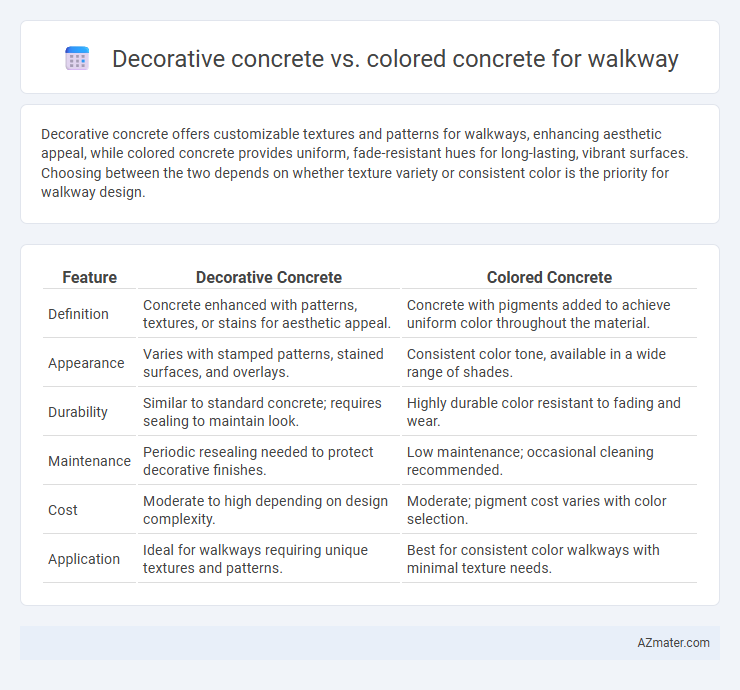Decorative concrete offers customizable textures and patterns for walkways, enhancing aesthetic appeal, while colored concrete provides uniform, fade-resistant hues for long-lasting, vibrant surfaces. Choosing between the two depends on whether texture variety or consistent color is the priority for walkway design.
Table of Comparison
| Feature | Decorative Concrete | Colored Concrete |
|---|---|---|
| Definition | Concrete enhanced with patterns, textures, or stains for aesthetic appeal. | Concrete with pigments added to achieve uniform color throughout the material. |
| Appearance | Varies with stamped patterns, stained surfaces, and overlays. | Consistent color tone, available in a wide range of shades. |
| Durability | Similar to standard concrete; requires sealing to maintain look. | Highly durable color resistant to fading and wear. |
| Maintenance | Periodic resealing needed to protect decorative finishes. | Low maintenance; occasional cleaning recommended. |
| Cost | Moderate to high depending on design complexity. | Moderate; pigment cost varies with color selection. |
| Application | Ideal for walkways requiring unique textures and patterns. | Best for consistent color walkways with minimal texture needs. |
Understanding Decorative Concrete for Walkways
Decorative concrete for walkways enhances curb appeal through various techniques like stamping, staining, and exposed aggregates, offering texture and intricate designs that elevate outdoor spaces. Colored concrete incorporates integral pigments or surface-applied dyes to provide uniform or variegated hues, but decorative options extend beyond color to include patterns and finishes that mimic natural stone or brick. Selecting decorative concrete maximizes aesthetic versatility and durability, making walkways both functional and visually striking.
What Is Colored Concrete?
Colored concrete is concrete that has been mixed with pigments to achieve a specific hue throughout the entire mix, ensuring uniform color and lasting vibrancy. It differs from decorative concrete, which may include stains, stamps, or overlays to create patterns and textures on the surface, rather than a consistent pigment throughout. Colored concrete is ideal for walkways requiring durable, fade-resistant color that integrates seamlessly with the concrete matrix.
Key Features of Decorative Concrete
Decorative concrete for walkways offers diverse textures, patterns, and finishes that enhance aesthetic appeal while providing durability and slip resistance. Techniques such as stamping, staining, and scoring create intricate designs mimicking natural stone or brick, making it ideal for customized visuals. Colored concrete primarily focuses on pigment integration for uniform or variegated hues but lacks the extensive textural and design versatility found in decorative concrete.
Color Options and Techniques in Colored Concrete
Decorative concrete for walkways offers a variety of finishes such as stamped, exposed aggregate, and stained surfaces that enhance texture and visual appeal without altering the base color. Colored concrete provides a broader palette of color options through integral pigments, color hardeners, and acid staining to achieve uniform or variegated hues that resist fading. Techniques like dry-shake color hardening and acid staining enable customized designs and long-lasting vibrant colors tailored to specific aesthetic preferences.
Durability of Decorative vs Colored Concrete Walkways
Decorative concrete walkways often incorporate stamped patterns and textured surfaces combined with dyes or stains, enhancing aesthetic appeal while maintaining robust durability against weathering and foot traffic. Colored concrete relies primarily on integral pigments, offering consistent color throughout the slab and strong resistance to fading and chipping, which contributes to long-lasting performance in outdoor conditions. Both options provide durable solutions, but decorative concrete's additional protective sealants and surface treatments can extend the lifespan of walkways exposed to harsh environments.
Aesthetic Appeal: Patterns, Textures, and Colors
Decorative concrete offers a versatile aesthetic appeal for walkways through intricate patterns, stamped textures, and a wide range of finishes that mimic natural materials like stone or brick. Colored concrete provides uniformity with pigments mixed into the concrete, allowing for consistent hues that enhance curb appeal but typically lack the textured variation seen in decorative options. Combining both techniques can create visually striking walkways by blending vibrant color with detailed patterns and textures for a custom look.
Installation Process Comparison
Decorative concrete installation for walkways involves stamping, staining, or engraving, requiring skilled labor to achieve intricate designs and textures that mimic natural materials. Colored concrete installation incorporates integral pigments mixed into the concrete before pouring, ensuring uniform color throughout the slab with minimal post-pour processing. Both methods need proper surface preparation and curing, but decorative concrete demands additional steps like sealing and detailed finishing, making its installation more labor-intensive compared to the straightforward pouring and finishing of colored concrete.
Maintenance Needs: Decorative vs Colored Concrete
Decorative concrete walkways often require regular sealing and occasional surface repairs to maintain their intricate patterns and textures, preventing wear from foot traffic and weather exposure. Colored concrete, with pigments integrated throughout the mix, generally has lower maintenance demands since its color does not fade as quickly and minor surface damage is less noticeable. Both types benefit from periodic cleaning, but decorative concrete typically needs more frequent upkeep to preserve aesthetic details compared to the more uniform appearance of colored concrete.
Cost Considerations for Walkway Projects
Decorative concrete for walkways often incurs higher initial costs due to intricate stamping, engraving, or staining techniques that enhance visual appeal. Colored concrete typically offers a more budget-friendly option by integrating pigments directly into the concrete mix, reducing labor and material expenses. Project size and desired aesthetic complexity strongly influence the overall cost, with decorative concrete demanding more specialized workmanship compared to colored concrete.
Choosing the Best Option for Your Walkway
Decorative concrete offers intricate patterns and textures that mimic natural materials, providing a unique aesthetic for walkways, while colored concrete delivers vibrant, uniform hues that withstand weathering and heavy foot traffic. When choosing the best option for your walkway, consider factors such as design preference, maintenance requirements, and long-term durability. Opt for decorative concrete if you prioritize customization and artistic appeal; select colored concrete for consistent color retention and ease of upkeep.

Infographic: Decorative concrete vs Colored concrete for Walkway
 azmater.com
azmater.com